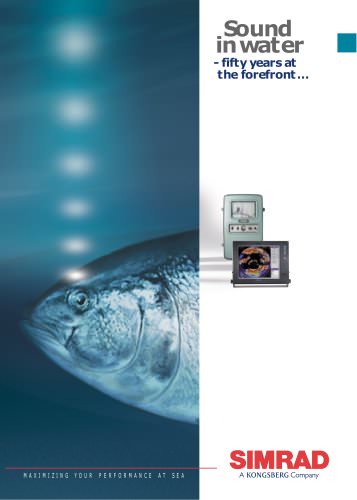
Catalog excerpts

Multibeam Systems SIMRAD TECHNOLOGY FOR SUSTAINABLE FISHERIES
Open the catalog to page 1
SIMRAD ME70 SCIENTIFIC MULTIBEAM ECHO SOUNDER A scientific multibeam echo sounder can be seen as many EK sounders spread out in a fan of beams. Where the EK provides multifrequency analysis, the ME70 adds to the picture with morphology and volume information, improved horizontal resolution and in general, it samples more cubic of water along the survey line. What makes the ME70 truly unique is that it combines the quantitative element from the split beam sounders with the resolution and the extended sampling volume from the multibeam world. As each beam is configured as split beam, standard...
Open the catalog to page 2
This picture shows a school of sand eel close to the bottom. The sand eel typically burrows in the sand to escape predators during daytime, while at night time it feeds on plankton and other small creatures. You can actually see how the school maintains contact with the sand even when the main population feeds in the water column. The only reason we can record such details near the bottom is the ultra-low sidelobes coupled with the advantages of frequency rotation between the beams. This data were recorded with the ME70 and has since then been processed and visualized by a third party...
Open the catalog to page 3
ME70 BATHYMETRIC OPTION The seafloor is an important component of the marine ecosystem. Perhaps you are looking at vegetation that grows on the bottom or fish that thrive near the bottom. Or perhaps the bottom structures themselves are of interest to the assessment such as presence of coral reefs in the area. The advantages of using a multibeam system when studying the seafloor are obvious, multiple detection points from an array of narrow beams are better than a single, wide beam. With the introduction of the ME70 scientists can now survey the seafloor while doing quantitative studies for...
Open the catalog to page 4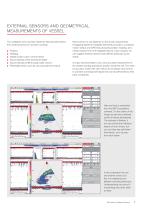
The multibeam echo sounder needs the following information from external sensors to function correctly: Position Heading Vessel motion: pitch, roll and heave Sound velocity at the transducer depth Sound velocity profile through water column Potentially others, such as very accurate time stamp Which sensor to use depends on the survey requirements. Kongsberg Maritime's Seapath 300 family provides a combined motion sensor and GPS that produces position, heading, and vessel motions from one integrated device. Upon request, we can suggest external sensors that fulfill the particular...
Open the catalog to page 5
SIMRAD MS70 SCIENTIFIC MULTIBEAM SONAR The MS70 provides an acoustic matrix of stabilized and calibrated beams for biomass estimation and study of school behaviour. Advanced beam forming is used to form 500 beams, spread out 60° horizontally by 45° vertically. As a result of this optimized horizontal transmission of narrow beams, the MS70 allows the user to detect and characterize schools of fish even very close to the sea surface. Where the ME70 adds a third dimension to your survey, the MS70 adds a 4th dimension. When you add up distance, vertical and horizontal swath of beams in addition...
Open the catalog to page 6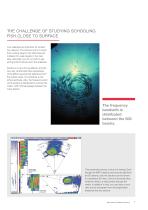
The frequency bandwith is distributed between the 500 beams. Low sidelobes are important for at least two reasons. The obvious one is to avoid that a strong target in the side lobes are mistaken for weak targets in the main lobe. Secondly, you do not wish to see strong bottom echoes from the sidelobes. Surface is a very strong reflector, and the two-way vertical side lobe suppression of the MS70 secures that reflections from the surface does not contribute to the school estimate. Also, the frequency band of the system is distributed out across the matrix, with minimal leakage between...
Open the catalog to page 7
SIMRAD TD50 MULTIBEAM 3D VISUALIZATION SOFTWARE The Simrad TD50 enables live streaming of 3D data generated by scientific multibeam systems. The Simrad TD50 software reads the incredibly clean raw data from the ME70 and MS70 in real time, and delivers accurate live visualisation of the oceanspace beneath the vessel to the scientific lab as well as any other location onboard wtih network access. Previously this data had to be post-processed before the 3D potential of the system was realised. Accurate 3D visualisation gives users a better understanding of the marine ecosystem by i.e. enabling...
Open the catalog to page 8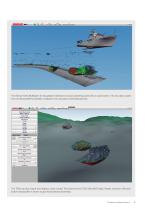
TD Software | Multibeam Systems 9
Open the catalog to page 9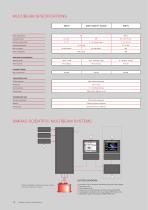
ME70 BATHY MODE MS70 Beam organization Operating sector Minimum beamwidths Operating frequency Max no. beams Beam stabilization Sidelobe levels Pulse duration DYNAMIC RANGE Max. source level TRANSCEIVER UNIT TX/RX channels CW or chirp 2 x 1 Gb Ethernet lines Physical size TRANSDUCER UNIT Number of elements Ceramic polymer composite Physical size SIMRAD SCIENTIFIC MULTIBEAM SYSTEMS Interface capabilities, uninterrupted power supplies and power cables are not shown. SYSTEM DIAGRAM A. Processor Unit for operation and beamforming with colour display B. Transceiver Unit C. Power Supply Units D....
Open the catalog to page 10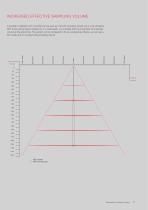
INCREASED EFFECTIVE SAMPLING VOLUME A scientific multibeam echo sounder can be seen as many EK sounders spread out in a fan of beams. With more narrow beams spread out in a wide swath, you increase both your resolution and sample volume at the same time. The system can be configured to fit your preferences. Below, we can see a 60° swath and its corresponding sampling volume. ME70 swath ME70 centre beam Specifications | Multibeam Systems
Open the catalog to page 11All Simrad catalogs and brochures
-
General Catalog
84 Pages
-
Single beam systems
12 Pages
-
Catch Monitoring Systems
16 Pages
-
Sonars
12 Pages
-
Product catalogue
84 Pages
-
Echosounders
8 Pages
-
Simrad main product catalogue
43 Pages
-
Simrad scientific systems
8 Pages
-
Simrad SH90
4 Pages
-
ES200-7C
2 Pages
-
ES70-18CD
4 Pages
-
Software release note
2 Pages
Archived catalogs
-
SIMRAD CATALOGUE
36 Pages
-
FS70 Trawl Sonar
2 Pages
-
SIMRAD Catlogue
36 Pages
-
Sonar brochures
22 Pages
-
Echo sounder brochures
36 Pages
-
Catch monitoring brochures
68 Pages
















